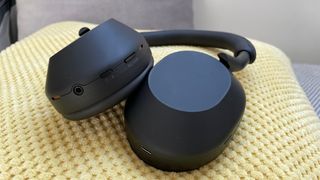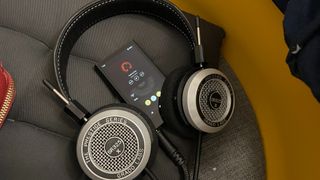Headphones come in all different styles, but one of the biggest misconceptions is that there's no difference between on-ear and over-ear headphones. They're both very different to earbuds, but that doesn't mean they're the same. Far from it.
On-ear headphones have become less popular in recent years, with manufacturers preferring to focus on over-ear models. But there are still plenty of on-ear options available – the Grado SR325x and Sony WH-C520 are both excellent wireless choices, while the Austrian Audio Hi-X50 are superb for fans of wired models. (For more, check out guide to the best on-ear headphones).
Both on-ear and over-ear models come in wired, wireless and noise-cancelling varieties, so there's plenty of choice whatever your needs. Not sure which is for you? Let's break down the differences between on-ear and over-ear headphones.
On-ear vs over-ear headphones: what's the main difference?
The main difference is how they fit. On-ear headphones have smaller earcups, meaning they sit on your ear. Over-ears have larger earcups that completely engulf your ears – hence they sit 'over' your ears.
A simple way to tell if someone is wearing on-ear or over-ear headphones is whether you can see their ears or not. If you can, they're wearing on-ear headphones. If their ears are completely hidden, they're wearing over-ears.
On-ear headphones sometimes come with a neckband instead of a headband (this rests on the back of the wearer's neck, instead of the top of their head). This design is more common with earbuds, however (though even then it's not all that common).
Because of their nature, on-ear headphones tend to be smaller than over-ear headphones and so take up less space in a bag or pocket. But some people find certain pairs clamp a bit too tightly on their ears, exerting more pressure than is comfortable.

On-ear vs over-ear headphones: which are better for noise cancelling?
Because they completely enclose your ears, over-ears provide a more immersive listening experience while also giving better physical noise isolating properties – by covering your ears, they provide a physical barrier to outside sounds. Which gives them a head start when it comes to noise cancellation.
Over-ear headphones are more common than on-ears, meaning there's more choice when it comes to noise-cancelling over-ear models. With competition fierce in the over-ear noise-cancelling market, pairs must perform brilliantly to stay competitive, which has pushed standards ever higher.
By sitting on your ears instead of covering them, on-ear headphones don't have this physical barrier between you and the outside world. And unlike earbuds, they don't provide physical noise isolation by sitting within your ear canal. This makes them less effective at noise cancellation.
They have other strengths, though. On-ear headphones typically make your ears less hot than over-ear pairs. The lack of a physical barrier to outside noise lets you stay more aware of your surroundings. They're smaller and so weigh less, which could make them more comfortable (though some people don't like the pressure on their ears). And because they're less bulky, they're less likely to interfere with any glasses or piercings.
On-ear vs over-ear headphones: which sounds better?
It really depends on the individual pair you're listening to. But typically the two styles do sound different.
It's not a hard and fast rule, but over-ears are usually more immersive and spacious, while on-ears are more direct. On-ears can also be open-backed, which gives them a more spacious soundstage, but that does mean they leak sound, and so are best kept for home listening.
In our experience, the best sound-per-pound performance at each price point lies with over-ear headphones. But that's hardly surprising given the sheer amount of choice on offer.

On-ear vs over-ear headphones: which are better for the gym?
We've all seen people pumping iron at the gym wearing a pair of over-ear headphones, but they would be better off with a pair of on-ears.
By encasing your ears completely, over-ears tend to make your ears hotter than on-ears – this is more noticeable over longer listening sessions, and some pairs are worse than others. Add exercise to the mix, and you've got a recipe for sweaty lug holes.
On-ears also keep you more aware of your surroundings, so you can hear when someone chastises you for not wiping down the weights bench when you've finished your set.
But because they're less bulky, earbuds are better than both for the gym.
On-ear vs over-ear headphones: which are better for kids?
It depends what you're looking for from a pair of kids' headphones. If you want immersive sound quality, over-ears will be best. If you want them to be more aware of their surroundings, on-ears are the smarter option. But still, good luck getting their attention.
MORE:
These are the best on-ear headphones
And the best over-ear headphones

